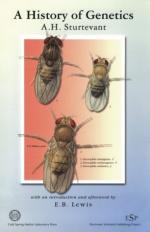|
This section contains 322 words (approx. 2 pages at 300 words per page) |
World of Scientific Discovery on Alfred Henry Sturtevant
Sturtevant demonstrated his interest in the genetically inherited characteristics early on at his family's ranch in Illinois where he would draw the pedigrees of his father's horses. As a young man, Sturtevant attended Columbia University, in part to be near his brother Edgar who was a professor at nearby Barnard. Edgar encouraged Sturtevant to pursue his interest in pedigrees by studying heredity. Sturtevant took his advice and, in 1910, began working with professor Thomas Hunt Morgan at Columbia University.
Sturtevant seemed to enjoy working the "fly room" (the nickname for Morgan's laboratory, so called because of the amount of fruit flies on hand for experiments), where new ideas were readily accepted and investigated. Morgan was already performing extensive experiments on Drosophila (the common fruit fly ) and his results helped supportGregor Mendel's theories that hereditary factors are independent of one another. But Morgan had also witnessed that some genes seemed to be linked together; in other words, they were not independent. For example, white-eyed flies were almost always male. Morgan and his team arrived at an explanation for this cross-over of linked traits. They maintained that genes that remain together when passing from one generation to the next must be located on the same chromosome.
Sturtevant proceeded to develop that concept and apply it to a real situation. Always a lover of mathematical puzzles, Sturtevant began to analyze how often certain genes were inherited together. From his analysis, he introduced the concept that the frequency of crossing-over between two genes gives us an idea of their distance from each other. If genes are located closer together on the chromosome, they are more likely to be inherited together. With those principles in mind, Sturtevant went home one evening and drew the first chromosome map--a detailed map showing gene positions on the four Drosophila chromosomes. Sturtevant's work helped convince Morgan that genes did exist and spurred his team to pursue genetic mapping of Drosophila.
|
This section contains 322 words (approx. 2 pages at 300 words per page) |


